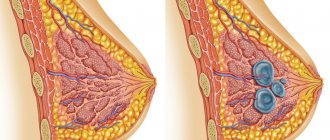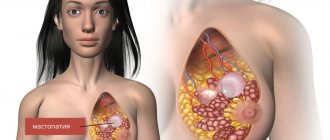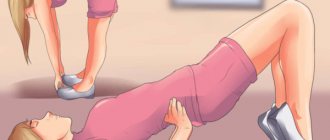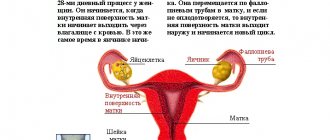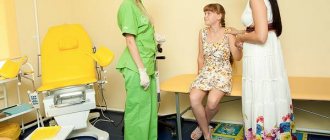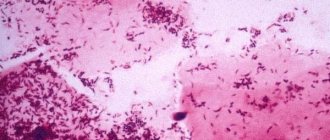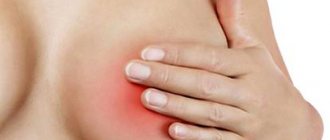| Only in the 20th century was PMS (premenstrual syndrome) identified as the cause of malaise in girls and women before their menstrual periods. PMS includes more than 150 symptoms that relate to both physiology and the mental sphere. Approximately 75% of women on the planet suffer more or less before menstruation. |
- How long does PMS last?
- Facts about PMS
- Causes of PMS
- Symptoms
- Forms
- Diagnostics
- PMS or pregnancy?
- Treatment of PMS manifestations
- What to do with PMS?
Causes of PMS
The causes of the syndrome have not been established to date. There are a number of theories:
- imbalance of salts and water in the body
- increased sensitivity to endogenous progesterone, which causes peculiar allergic manifestations
- changes in hormone balance
- psychosomatic features of the period, etc.
Today, doctors are most inclined to the hormonal theory of the syndrome. In the second phase of the cycle, the combination of the amount of sex hormones in the bodies of girls and women changes. It's no secret that a woman's health depends on the balance of hormones. Estrogens affect mental and physical well-being. Estrogen also affects:
- learning abilities
- ability to assimilate new information
- creativity
- general tone
Progesterones have a calming effect on the body, which explains the appearance of melancholic symptoms in the second phase of the monthly cycle. Androgens increase performance, overall energy levels, and sexual desire.
Hormones that change a few days before menstruation activate certain parts of the brain that are responsible for the emotions and behavioral reactions of a female person. PMS is characterized by somatic and psycho-vegetative disorders. The amount of estrogen increases, and the level of progesterone first increases and then falls, which explains the following symptoms:
- breast tenderness
- breast engorgement
- swelling
- fluid retention in the body
- tearfulness
- aggressive behavior and irritability
- cardiovascular disorders
Active production of prolactin is also responsible for swelling and the retention of excess sodium in the body. With PMS, the level of prostaglandins increases, which leads to headaches (as with migraines), digestive disorders, and vegetative-vascular disorders. During this period, the level of serotonin (the hormone of joy) in the body is low, so girls become depressed, fall into melancholy and despondency, and become apathetic or sad.
During the period before menstruation, a woman’s body becomes low in vitamin B6, which causes the following symptoms:
- fluid retention in tissues
- fatigue
- breast hypersensitivity
- mood changes for no apparent reason
Magnesium also decreases during PMS, which leads to the following symptoms:
- craving for chocolate or other sweets containing it
- headache
- dizziness
- tachycardia
Risk factors for PMS:
- obesity
- smoking
- abortions, childbirth with complications
- genetic predisposition to PMS
- operations
- gynecological pathologies
- infections
- stress
Climax
Between 45 and 50 years, a global restructuring occurs in a woman’s body - the reproductive system prepares for menopause. We have already mentioned this when talking about forty-year-old women. During this period, the nature of menstruation changes increasingly.
The cycle becomes even more irregular as ovarian function declines more noticeably. Often, bleeding becomes shorter and the cycle itself lengthens. So, if previously the discharge was observed for about 5 days, then before menopause the norm will be a duration of 3 days. The length of the menstrual cycle was usually 28 days, and on the eve of menopause it could even be 40-45 days, but more often - 35. The amount of bleeding can be either excessive or, on the contrary, small.
PMS symptoms in women 45 years old are very, very pronounced. The woman experiences excruciating nausea, is bothered by skin rashes, and is haunted by constant weakness and pain in the lower abdomen.
And not only does physiology respond to changes, but it is also psychologically difficult to accept the fact that an important female purpose remains in the past. After all, few people give birth to children at that age. A significant period of life has ended, the body is aging.
The most difficult thing becomes when menstruation stops altogether. Although for many women this is a relief - there will no longer be the pain and discomfort that caused life to stop for a couple of days. And yet, for every representative of the fair sex, this milestone represents stress due to loss.
If bleeding does not occur for a year, the gynecologist diagnoses menopause. And then the symptoms of PMS in women after 40-45 years, which cause so much discomfort, disappear. They are replaced by dry skin, headaches, and bad mood, which are very difficult to control.
Agree, it’s also not very pleasant. Women are especially frightened by the so-called hot flashes, when they break into a sweat and their blood pressure rises, causing dizziness and severe weakness. Fortunately, this surge does not last long. After a few minutes, the woman already feels normal.
The time of menopause depends on hereditary factors. If your female relatives had early menopause, then you will too. Now we know everything about PMS - at what age does it begin, what are its symptoms and when do they intensify and then disappear.
Symptoms
Symptoms of the premenstrual period in girls and women are divided into groups. The following neuropsychic manifestations are likely:
- tendency to cry
- irritability
- depression
- aggression
Vegetovascular disorders during PMS:
- headache
- blood pressure changes
- dizziness
- nausea and/or vomiting
- heartache
- increase in heart rate
Symptoms associated with disorders in the endocrine and metabolic systems:
- temperature rise
- swelling
- breast engorgement
- chills
- decreased vision
- memory impairment
- thirst
- dyspnea
- accumulation of gases in the intestines
- itching
Forms
The neuropsychic form of premenstrual syndrome involves the following manifestations:
- aggression (often over small things)
- dizziness
- increase in sexual desire or its significant decrease
- fairly frequent mood changes
- irritability
- insomnia
- forgetfulness
- inability to focus on something
- depression
- fears for no reason
- depression and melancholy for no reason
- anxiety disorders
- panic attacks (PA)
There is also a crisis form of PMS in girls and women, which manifests itself as follows:
- PA
- frequent urination
- heart pain
- blood pressure changes
- attacks of tachycardia
- diseases of the gastrointestinal tract, kidneys, blood vessels and heart
The edematous form of the syndrome in question includes the following manifestations:
- swelling of the face, arms and legs
- negative diuresis with fluid retention
- joint pain
- headache
- accumulation of gases in the intestines, diarrhea, constipation
- decreased urine output
- itchy skin
- weight gain
- desire to drink a lot of water
Another form of the syndrome is cephalgic. Girls experience the following symptoms:
- throbbing headache that radiates to the eyes
- heart pain
- migraine
- strengthening of vascular pattern
- hyperostosis
- increased sensitivity to smells and sounds
In this case, relatives and the girl herself most likely have diseases of the gastrointestinal tract, blood vessels and heart, and hypertension (persistent increase in blood pressure) is common.
Some women experience atypical symptoms (not typical for PMS):
- allergic manifestations
- vomit
- drowsiness
- increase in body temperature to 37.7°C
The course of premenstrual syndrome may be different for each girl. Moreover, in one cycle there may be one symptom, and in another it will change slightly. Most often, the following symptoms appear with PMS :
- irritability (in 94 girls out of 100)
- breast tenderness (in 87 girls out of 100)
- bloating (in 75 girls out of 100)
- tearfulness (in 69 girls out of 100)
- increased sensitivity to odors, headache (in 56 girls out of 100)
- swelling (in 50 girls out of 100)
Some diseases are activated during PMS:
- epilepsy
- anemia
- thyroid diseases
- migraine
- allergies
- inflammation of the female sphere, etc.
Changes
After forty years, the hormonal background changes and the ovaries no longer work so actively, their function gradually fades away. A decrease in the amount of hormones affects the nature of monthly bleeding. The cycle becomes irregular.
The abundance of menstruation varies: either there is too much discharge and you have to change the pad almost every hour, or one pad is enough for 2-3 hours. And all this fits into the norm. If you are concerned about the changes that have occurred, visit a gynecologist and discuss your condition with him.
A lack of female sex hormones leads to the following symptoms of PMS in women after 40 years of age:
- unmotivated mood swings;
- pain in the lower abdomen and lumbar region;
- arterial hypertension;
- nausea;
- headaches and dizziness;
- fast fatiguability;
- increased body temperature;
- feeling of heat or chills.
Considering this age, we can firmly say at what age PMS begins to really bother women - after 40 years. If previously there might have been a slight discomfort that did not particularly interfere with normal life, now the process proceeds like a disease that requires attention.
Some women do not seek to alleviate their condition and simply endure. They spend years of their lives suffering, although they can change their tactics and help themselves. If we don’t remove the symptoms, then at least smooth them out. The first step should be to contact specialists:
- After examination and complaints, the gynecologist will prescribe tests to find out which hormones are missing.
- A neurologist will help you improve the functioning of your nervous system if it is very difficult for you not to get irritated by little things and to restrain your aggression.
- An endocrinologist will conduct an examination to confirm or rule out endocrine pathologies and other conditions associated with hormonal changes.
There is no clear answer to the question: At what age does PMS begin? Even young girls have some symptoms to one degree or another. Most often, the breasts react to changes - they become a little fuller and hurt. And the mood changes in almost all women before menstruation.
Diagnostics
Girls and women need to monitor their monthly cycle for many reasons. Dates jump out of your head, so you need to keep a diary or menstruation calendar. Many modern phones have special applications that will help you understand when you have your period (were and will be), when you have PMS, and when you are ovulating (egg release, high chances of fertilization). If you write down the signs of PMS, you can easily identify the symptoms that are typical for you.
A mild form of PMS is diagnosed if there are 2-4 symptoms, and a severe form if there are 5 or more. Sometimes this period can make a woman unable to work. PMS is a cyclical condition. If disturbing symptoms do not disappear with the onset of menstruation and continue in the first phase of the cycle, then you should consult a doctor, because this may not be PMS, but something more serious.
If pain appears before and during menstruation, as well as in the presence of blood discharge (not related to menstruation), one should suspect gynecological pathology, and not PMS:
- dysmenorrhea
- chronic endometritis
- endometriosis
- ovarian cyst, etc.
The doctor may order a test of hormone levels:
- progesterone
- estradiol
- prolactin
Sometimes other studies are needed. If in the period before menstruation there is tinnitus, dizziness or a headache, you need to conduct a magnetic resonance imaging or CT scan, because PMS in such cases can mask organic brain diseases. If there is severe swelling and the amount of urine excreted per day changes, it would be a good idea to examine the kidneys. After all, it is this organ that is responsible for processing fluids in the body and removing them out.
If you are concerned about the condition of your breasts during PMS (severe pain, severe engorgement), your doctor may prescribe a mammogram or ultrasound. It is necessary to differentiate PMS from various organic pathologies in this area.
In addition to the gynecologist, the girl can turn (depending on the disturbing symptoms) to the following specialists:
- therapist
- cardiologist
- nephrologist
- endocrinologist
- neurologist
- psychiatrist
When does PMS start?
The classification of premenstrual syndrome, in addition to dividing according to symptomatic manifestations, also implies a compensated and decompensated form. This is what determines when the symptoms of premenstrual syndrome begin to appear:
- The compensated form begins to manifest itself three to five days before menstruation and goes away with its onset. Most often, this manifestation of premenstrual syndrome lasts up to one week.
- The decompensated form is more complex and begins five to ten days before the start of menstruation, does not end during menstruation, but only five to ten days after the end of menstruation. Thus, the manifestation of symptoms can last up to twenty days, and sometimes for a whole month.
On average, the answer to the question of how many days before menstruation PMS symptoms begin to appear is seven to ten days.
PMS or pregnancy?
Many men are interested in the question of what PMS is in girls in order to understand whether their partner is pregnant. After all, many manifestations of the syndrome and pregnancy are similar. When conception occurs, a girl's body becomes high in progesterone. The same trend is observed with PMS.
| Symptom/Manifestation | Symptom features of PMS | Features of symptoms during pregnancy |
| Changes in appetite | A girl may want something salty (chips, various snacks, etc.), or she may want something sweet (desserts, chocolate, etc.). Increased sensitivity to odors is also common. | Cravings for salty, inedible things (chalk, indoor plants, etc.), for those foods that the woman has not previously eaten. Ordinary odors can cause irritation and disgust. |
| Breast soreness | On the first day of menstruation, the symptom disappears. | The symptom is typical throughout the 9 months of gestation. |
| Increased fatigue | In many girls, the symptom appears after ovulation or 2-5 days before the onset of menstruation. | Symptoms appear from the 4-5th week of gestation. |
| Back pain | There is pain in the lumbar region (not everyone). | Pain appears in the later stages, and not always. |
| Toxiosis | There may be symptoms such as nausea and even vomiting. | Manifestations of toxicosis usually begin in the 4th or 5th week from conception. |
| Frequent urge to go to the toilet “small” | Not typical for PMS. | Possible in some pregnant women, depending on the size and position of the fetus and the physiological characteristics of the woman. |
| Emotional sphere | Mainly increased irritability, but frequent mood swings are also likely. Depression, apathy and other symptoms discussed above. | The mood often changes, a woman may cry for no reason or over trifles. |
| Lower abdominal pain | There may be, or there may not be. | The pain is not severe and goes away quickly. |
To understand whether it is PMS or pregnancy, you can wait for the onset of your period. If there is a delay, it's time to take a pregnancy test at home. We have already noted that tests conducted earlier did not produce results.
An increase in the pregnancy hormone (hCG) is determined at an earlier stage using special blood tests, which you can take at your nearest laboratory. This way you will get the result faster than using a home test.
The best way to determine whether you have PMS or pregnancy is to see a gynecologist. The doctor will feel the uterus and understand what condition it is in. If pregnancy is likely, you will be advised to have an ultrasound.
Treatment of PMS manifestations
Treatment for PMS helps to get rid of symptoms or reduce their manifestation. Psychotherapy is recommended if you have the following symptoms:
- depression
- increased irritability
- sudden mood swings
Sedatives are also used if the symptoms described above negatively affect the life of the girl and her loved ones.
Any pain due to PMS can be corrected by the following means:
- analgin
- nimesulide
- ibuprofen
- ketanov, etc.
For edema, it is important to take diuretics as prescribed by a doctor. If the doctor advised to conduct functional diagnostic tests, which confirmed the insufficiency of the 2nd phase of the cycle, then hormones are prescribed for treatment. Neuropsychiatric symptoms require treatment with the following drugs (only as prescribed by a doctor):
- Tazepam
- Rudotel
- Amitriptyline
- Prozac
- Zoloft
- Sertraline
- Sonapax, etc.
If a woman has an edematous or cephalgic form of the syndrome, then antiprostaglandin drugs are recommended and should be used in the 2nd phase of the cycle. If the amount of histamine and serotonin in the body increases, the doctor may prescribe second-generation antihistamines, which should be taken 2 days before the expected onset of PMS symptoms (drink at night, before the second day of menstruation).
To improve blood circulation in the central nervous system, the doctor may prescribe the following drugs:
- Aminolon
- Nootropil
- Grandaxin
If there are neuropsychic, cephalgic or crisis manifestations, 3-6 month courses of drugs such as Difenin or Peritol are prescribed.
What to do with PMS?
Follow simple rules to easily cope with PMS:
- sleep 8-10 hours
- if you can't sleep, take a walk in the fresh air before bed, meditate or try aromatherapy
- aromatherapy can be used not only during the day, it can, in principle, relieve PMS symptoms. Sage, rose and geranium oils are relevant. Basil and lavender oils will help with cramps.
- 2 weeks before menstruation, take baths with aromatic oils.
- Exercise regularly, dance, or at least jog at any time convenient for you. Physical activity increases the amount of joy hormone in the body.
- 2 weeks before the start of menstruation, you can take Magnerot, Magne B6, vitamin B6, A, E to get rid of irritability, insomnia, and cardiac manifestations of PMS.
- Remove cola, chocolate, coffee and coffee drinks from your diet during PMS, which aggravate anxiety and irritability.
- Include foods high in calcium and fiber in your diet. And also eat more vegetables and fruits.
- During PMS, your diet should contain a minimum of fat. Also avoid beef, which often contains artificial estrogens.
- At the first manifestations of the syndrome, include fresh carrots and herbal teas in your diet. It is better to avoid alcohol; it negatively affects carbohydrate metabolism and many other processes that aggravate the course of PMS.
- Try not to expose your body to stress, do yoga and meditation.
- Have sex regularly. This stimulates the production of endorphins.
- Plants and preparations on a natural basis help well with PMS (Vitex, St. John's wort, primrose)
Menstruation and premenstrual syndrome
A woman’s body is designed in such a way as to procreate, and all the processes occurring in it contribute to this. At approximately 11-13 years old, a young girl’s body begins to change—menstruation or menstruation begins. Now your menstrual bleeding will come monthly, starting your menstrual cycle.
The menstrual cycle in women is the period of time that begins on the first day of menstrual bleeding and ends on the day before the start of menstruation in the next month. The duration of the cycle can be 21-35 days, and menstruation itself normally lasts 3-7 days.
Menstruation is a bloody discharge that contains clots, mucus and lumps. This is how the endometrium of the uterus is rejected and removed from the body along with the blood. At the same time as the endometrium, an unfertilized egg is released. At this time, a new egg in the ovary begins to grow in order to expect fertilization again next month. The volume of discharge depends on the personal characteristics of the female body, which explains more scanty or more profuse bleeding. On average, a woman loses 50 ml of pure blood during her period, although it may seem to her that this figure is much higher. The highest intensity of bleeding is on the 2-3rd day of menstruation, then it begins to gradually decrease.
In the days before bleeding begins, women of all ages may experience a range of symptoms called premenstrual syndrome. PMS can last 2-10 days and is expressed in a slowdown or intensification of the work of the nervous, endocrine, cardiovascular systems of the body, as well as metabolic disorders. The older a woman is, the more susceptible she is to PMS.
Under the influence of certain factors, the syndrome develops:
- frequent stressful situations;
- childbirth and previous abortions;
- past infectious diseases;
- excessive weight;
- lack of sufficient physical activity;
- smoking, drinking alcohol and strong coffee.
PMS is classified depending on intensity, quantity and duration. So, with pronounced 1-2 symptoms, and a total of 4-5 of them are observed, a mild degree is diagnosed 5-10 days before the onset of menstrual bleeding. If, 2 weeks before menstruation, there are many PMS symptoms, and 5-7 of them prevent a woman from living her usual life, this indicates a severe degree of the syndrome.
There are three stages of PMS:
- Compensated. The symptoms do not progress, appear in the second phase of the menstrual cycle, and when menstruation begins, disappear.
- Subcompensated. Symptoms progress and disappear only with the onset of menopause.
- Decompensated. Manifestations persist even after menstruation.
